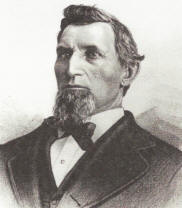|
Then and Now:
"Buffalo Bill" Mathewson Home
.jpg) |
THEN: Sketch of the second Wichita home of "Buffalo Bill" Mathewson
built at the location of his original log cabin on East Central
|
|
|
William "Buffalo Bill" Mathewson 1830-1916
|
Buffalo Bill Mathewson is one of the more flamboyant figures in Wichita’s Cowtown past, and the homes he built comprise both this issue’s THEN and NOW.
William Mathewson, born Jan. 1, 1830 in Triangle, Broome County, New York, earned his first nickname, "Sinpah Zilbah" (long-bearded dangerous white man), when he defeated Kiowa chieftain Satanta in 1861.
It was that same year that he earned his more famous nickname. Mathewson lived on a ranch on the "Great Bend of the Arkansas River" and ran a trading post which he had opened in 1853.
In the summer of 1860, scorching winds destroyed all the crops in the eastern part of Kansas, and, by the winter of 1861, settlers were starving.
Mathewson, however, was shooting hundreds of buffalo on the prairies around him, and word got out that his was the place to go for food. After providing wagon loads of buffalo meat to starving settlers and not even charging those who could not pay, he became known as "Buffalo Bill."
Wichitans have considered him to be the authentic Buffalo Bill ever since.
While an 1889 article in the Wichita Beacon says Mathewson built Wichita’s first log cabin, J.R. Mead wrote a correcting letter to the editor in 1908 which said, "During 1867, 1868, 1869 to the spring of 1870, Mr. Mathewson was in the employ of the government at his trading post at the Kiowa and Comanche agency six miles from Ft. Sill. I was here supplying him with goods in 1868 and 1869 and attending to transportation. All this time the quarter section adjoining mine on the east laid vacant, so in the latter part of July 1869 I staked and held it for Mr. Mathewson and made the necessary improvements to hold it for him, which at that time consisted of a notice of location written on a board stuck in the ground, four logs laid as a foundation, breaking half an acre of ground, and registering a notice with Mr. D. S. Munger of the Munger hotel, who kept records of all claims taken, was postmaster, hotel keeper, etc. Mr. Mathewson knew nothing of my taking the claim for him until I wrote him later."
Nevertheless, that cabin was one of the earliest buildings in Wichita, and Mathewson’s wife is acknowledged as the first white woman to set foot on what is now Sedgwick County, having come here in 1864.
The log cabin was built on Central, near Ohio Street, on a quarter section of land that became knows as "Mathewson’s Pasture." It ran from Wabash to Hydraulic and from Central to Douglas.
Volume III, part 2 of Kansas: a cyclopedia of state history said Mathewson was "a live stock and real estate dealer and, in 1887, organized a bank in Wichita, of which he was president. In 1878 he established a brick plant, south of the city, and for many years, until he sold his farms, devoted himself principally to agriculture and obtained a gold medal for the best exhibit of corn at the Omaha exposition."
By 1874 Mathewson had built a two-story, 18 X 36 foot house nearby, and the log cabin was falling down.
A June 5, 1889 article in the Beacon said, "Since it was vacated, relic hunters have almost demolished it. The door has been hacked piece by piece with pocket knives until only the hinges are left. A year ago the Burton car works obtained a load of logs from the building and made all kinds of swell articles from it to be distributed to its patrons as souvenirs of the city’s first residence. Mr. Mathewson will retain the remains of the cabin and construct a ‘play house’ for his children."
Mathewson amazed Wichitans by building "one of those wind mills for the purpose of water supply" and improved the grounds with fences and "a half mile of trees – a regular avenue of them."
In 1896, however, Mathewson’s bank was defunct, and he sold half his land. Then, in 1906, he sold the rest of his property and purchased the Dr. J.C. Wilson residence at 605 South Topeka.
This modest one-story house was quite a comedown from the grand two-story house on Central, but by 1913 Mathewson’s finances had once again improved, and he and his third wife moved into a two-story foursquare at 1047 North Market. That house is still standing.
While fans of the Wild West remember Buffalo Bill Mathewson as an Indian fighter and buffalo hunter, lifetime Wichitans "of a certain age" still remember Mathewson’s Pasture.
Some were warned not to cross the pasture on their way to school because of the bull Mathewson kept there.
Others remember the great fun they had when the circus would come to town and set up in that area.
Still others remember that the first Joyland was situated on Mathewson’s Pasture.
Whatever the memories, Wichita does still have the last of Mathewson’s homes, and perhaps even the resurrection of the second Joyland will serve as a reminder as well.
(Notes for the above article were gathered, in part, from the Tihen Notes, Special Collections, WSU.)
| NOW: The fourth Wichita home of
"Buffalo Bill" Mathewson remains at 1047 N. Market (Photo credit: D & V Churchman) |
|
| NOW: The site of "Buffalo Bill"
Mathewsons’s home at 1201 E. Central is now occupied by Bikers Edge.
Photo by Churchman
(Photo credit: D & V Churchman) |
|
